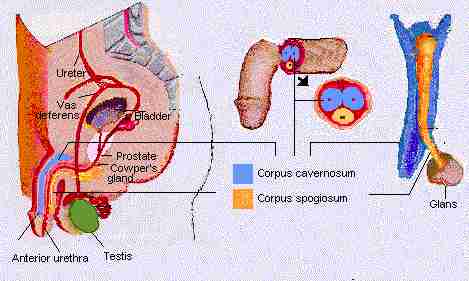

3 of 13
Erection's Process in Man
 Erection
is the blood flow temporarily increased and trapped in the penis so that
it becomes elevated and enlarged. Vasocongestion in this and other areas
is the man's primary physiological response to sexual stimulation.
Erection
is the blood flow temporarily increased and trapped in the penis so that
it becomes elevated and enlarged. Vasocongestion in this and other areas
is the man's primary physiological response to sexual stimulation.
The penis consists of three cylindrical masses of erectile tissue, two corpora cavernosa which lie side by side and above a third cord of erectile tissue, the corpus spogiosum urethrae, which transmits the urethra. The expanded distal end of the corpus cavernosum forms the glans. The expanded corpus cavernosum extends in the midline to the point of entry of the prostatic urethra and is also covered by a sheet of skeletal muscle, the bulb cavernosus.
The erectile tissue of the corpora cavernosa is a spongelike system of irregular vascular spaces that are interspersed between the arteries and veins. In the flacid state these spaces are more or less collapsed and contain little blood; during erection they are quite large cavities distended with blood. This is the imediate mechanism of erection.
When a man becomes sexually excited, the first change that occurs in the penis is the increasing of its length. Only then will the volume begin to increase, - until it finally reaches the increase of about 200 percent - while the blood fills the arteries of the penis. When these arteries dilate, the blood pressure forces it - now with eight times the quantity that occurs in the flaccid penis - to fill the cavernous spaces. Inside the cavernous bodies, the blood is absorbed by the erectible and spongeosum tissues, with its system of inflatable spaces. Thus, the erection is a two part process: the glans and the spongeosum tissues give volume, while the cavernous tissues give rigidity.
The firmness of the erection depends on the maintaining of a high blood pressure in the cavernous bodies, and this depends on the veins. The blood flux system must close so that it avoids escape; otherwise, the erection will not be maintained. In some male sexual disturbances, such as the "vasculogenic impotence" was created to describe the condition produced in some cases, by a disease of the arteries of the penis, in which these vessels become progressively obstructed.
See the dynamic process of erection
Go to the first page of
this article
Author: Silvia Helena Cardoso, PhD. Psychobiologist, master and doctor in Sciences by the University of São Paulo and post doctoral fellowship by the University of California, Los Angeles. Invited Professor and Associate Researcher of the Center for Biomedical Informatics, State University of Campinas (Unicamp), Brazil.
Center for Biomedical Informatics
State University of Campinas, Brazil
Copyright 1997 State University of Campinas